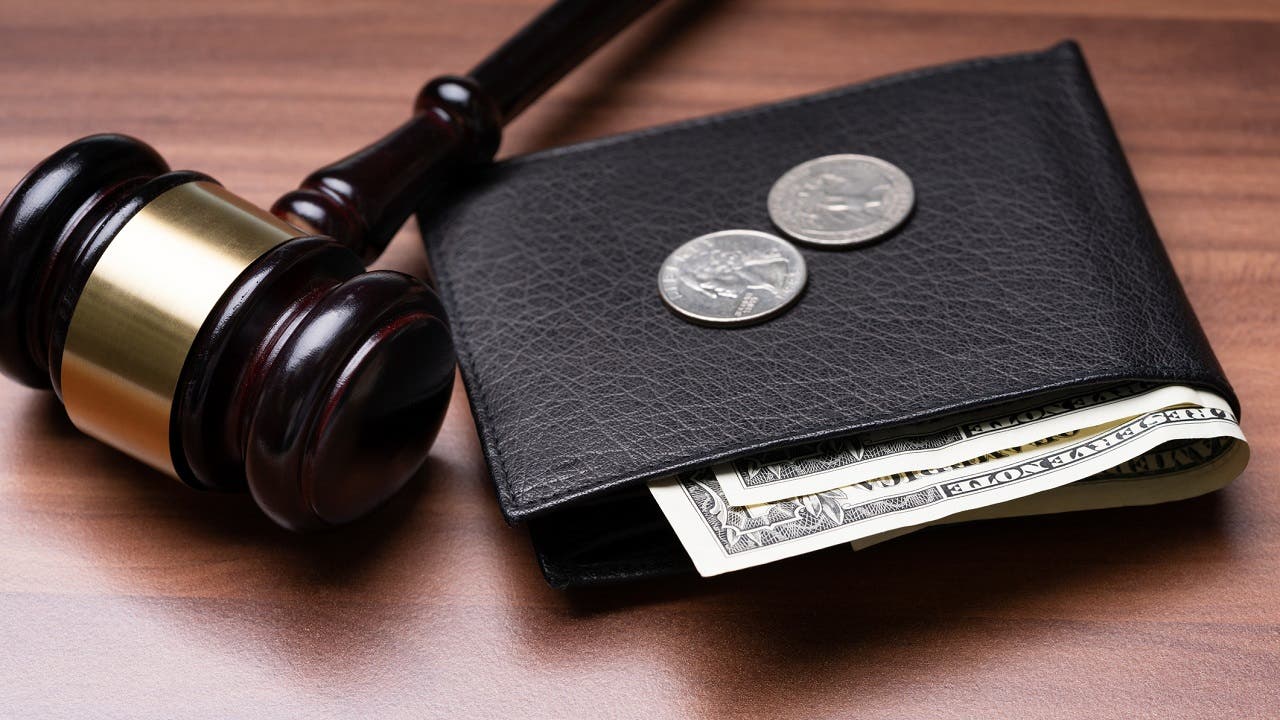Can bankruptcy stop wage garnishment?

Key takeaways
- Wage garnishment is the withholding of a portion of your earnings from your paycheck to pay off a debt, often due to a court order.
- The average wage garnished for private workers is 10 percent. In some cases, it can exceed 25 percent.
- Though not guaranteed, bankruptcy could protect you from garnishment. However, the effect on your credit is long-lasting, so it should be considered a last resort.
- Other ways to stop garnishment without filing for bankruptcy include settling your debt with creditors and fighting back in court.
Many American workers face wage garnishment. According to a Kellogg study, about one percent of private-sector workers have at least one wage garnishment. The average garnishment is about 10 percent of a worker’s gross income — equal to what most people spend on groceries for the month.
If you’re struggling to make ends meet due to wage garnishment, filing for bankruptcy may protect you from creditors and provide some financial relief. However, it’s important to understand the rules, including scenarios where bankruptcy won’t yield the desired results.
What is wage garnishment?
Wage garnishment is a legal process where an employer withholds a portion of an individual’s earnings from their paycheck to pay off a debt, usually due to a court order. It can occur when someone owes money for unpaid taxes, child support, student loans or consumer debt such as credit cards or medical bills.
The amount garnished is typically a percentage of the person’s disposable income and goes directly to the creditor until the debt is paid off. Under U.S. federal law, creditors can typically garnish no more than 25 percent of disposable income.
Before garnishment occurs, the creditor must first win a court case, unless it’s for child support, student loans or taxes. In those cases, garnishment can happen without a court order. Employers are legally required to comply with wage garnishment orders. Failure to do so could result in penalties.
Does bankruptcy stop wage garnishment?
Bankruptcy has the potential to stop wage garnishment. In many bankruptcy cases, an automatic stay — a court order that prevents most creditors from continuing debt collection activities like wage garnishment — will go into effect after the bankruptcy petition is filed.
What types of garnishments are not stopped by bankruptcy?
Bankruptcy isn’t a silver bullet where wage garnishment is concerned. It may not prevent wage garnishment under the following circumstances:
- Certain tax debts: Some wage garnishments related to unpaid taxes, especially recent federal, state or local taxes, may not be stopped by bankruptcy. The IRS and other tax authorities may continue garnishing wages despite the automatic stay.
- Child support and alimony: Bankruptcy does not stop wage garnishments for domestic support obligations, such as child support or spousal support (alimony). These are considered priority debts and continue to be collected even after filing for bankruptcy.
- Criminal fines and restitution: Bankruptcy does not stop garnishments to repay criminal fines, court-ordered restitution or penalties related to criminal offenses.
- Student loans (in some cases): While bankruptcy usually stops student loan garnishments temporarily during the automatic stay, discharging student loans is much more difficult. If the debt is not discharged, garnishment may resume after the case is resolved.
How to stop wage garnishment with bankruptcy
Bankruptcy can stop most garnishments and provide relief from creditors’ actions. Here’s how it works.
1. Determine eligibility for bankruptcy
You’ll first need to determine which type of bankruptcy you wish to file. For individuals, there are two options:
- Chapter 7 bankruptcy: This is a liquidation bankruptcy that wipes out most unsecured debts, such as credit card debt or medical bills. If you qualify based on income and other factors, filing can stop wage garnishment quickly.
- Chapter 13 bankruptcy: This type of bankruptcy allows you to set up a repayment plan to pay off debts over time (usually three to five years). It can stop garnishment and allow you to make manageable payments.
2. File for bankruptcy
Once you’ve decided on Chapter 7 or Chapter 13 and confirmed your eligibility, you can file for bankruptcy. This involves preparing the necessary documents, paying filing fees and possibly hiring a bankruptcy attorney. You must submit paperwork to the bankruptcy court, including a list of your debts, income, assets and expenses.
3. Confirm the automatic stay
Once your bankruptcy petition is filed, the automatic stay immediately takes effect. This stay is a legal order that halts all collection actions by creditors, including wage garnishment. Your employer will be notified, and they must stop garnishing your wages.
4. Discharge your debts
In Chapter 7, once your bankruptcy case is completed (typically four to six months), your dischargeable debts will be wiped out, and the wage garnishment will permanently stop for those debts.
In Chapter 13, your debts will be restructured into a repayment plan. Garnishment stops because the debt will be handled through the court-approved repayment plan.
5. Monitor accounts after bankruptcy
Monitor your wages after filing and receiving your discharge to ensure garnishment has stopped. If your employer continues garnishing wages after the automatic stay takes effect, notify them immediately and consider taking legal action if necessary. It’s illegal for creditors to garnish wages after receiving a bankruptcy notice.
Filing for bankruptcy can immediately relieve wage garnishment and help you regain financial stability. Note that bankruptcy laws and procedures can vary by state. It’s best to speak with a licensed attorney for legal advice about your situation.
Other ways to stop wage garnishment
Bankruptcy can have significant adverse effects on your credit and long-term financial health. A bankruptcy filing stays on your credit report for seven to 10 years, making obtaining loans or credit cards difficult. Even if credit is available, it often comes with higher interest rates and less favorable terms.
Fortunately, there are other methods to stop wage garnishment, depending on the type of debt and the legal circumstances of the garnishment.
Negotiate with the creditor
Contact the creditor directly and attempt to negotiate a lump-sum settlement or a payment plan allowing you to pay off the debt without wage garnishment. Creditors may agree to stop garnishment if they believe they can recover the debt through negotiation.
Even if you can’t pay off the debt immediately, creditors may agree to a hardship program that provides temporary relief, such as lower monthly payments, if the garnishment is causing financial hardship.
Claim exemptions
Many jurisdictions allow debtors to claim certain exemptions from wage garnishment, which can protect a portion of their income from being garnished. For instance:
- Head of household exemption: If you are the primary provider for your household, you may qualify for an exemption that limits or prevents wage garnishment.
- Income below a certain threshold: If your earnings are below a certain threshold, garnishment may be limited under state or federal law.
You must file a claim of exemption with the court, explaining why your wages should not be garnished or why the garnishment should be reduced.
Pay off the debt in full
While this option may not be feasible for everyone, paying off the total debt immediately stops the garnishment. If you can gather enough funds through savings, loans or help from family and friends, paying off the debt in full will release you from any further garnishment.
Enter a debt repayment program
Consider working with a credit counseling agency if your wage garnishment results from consumer debt (such as credit cards or medical bills). These agencies can help you set up a debt management plan (DMP), consolidating your debts into a monthly payment.
Some creditors may agree to stop garnishing wages if you enroll in a DMP and make consistent payments toward your debt.
Challenge the underlying judgment
Wage garnishment usually happens after a creditor obtains a court judgment against you. If you were unaware of the judgment or believe there was a mistake, you may have grounds to challenge it. You can do this by filing a motion to vacate the judgment.
If you were not properly served notice of the lawsuit or missed court appearances for valid reasons, you may be able to overturn the judgment.
Consolidate or refinance debt
If wage garnishment is related to student loans, you can apply for loan consolidation or rehabilitation to stop garnishment. The federal government may withhold up to 15 percent of your pay until your defaulted loans are repaid. Entering into a rehabilitation or consolidation program can stop wage garnishment and allow you to make affordable payments.
You may also be able to refinance certain types of debt, such as personal loans or credit card debt, to lower interest rates, make payments more affordable and avoid default or wage garnishment.
File for a hardship exemption
In some cases, you can apply for a hardship exemption with the court if the garnishment creates undue financial difficulty. This is more common with government-related debts (like federal student loans or taxes), and the court may reduce or stop garnishment temporarily if you can demonstrate that it affects your ability to pay for necessities like rent, utilities and food.
The bottom line
Bankruptcy can stop most wage garnishments through an automatic stay, but it won’t stop garnishments for child support, alimony or certain tax debts. There are other ways to avoid wage garnishment without hurting your credit as much as bankruptcy, including debt consolidation and debt management programs.
The best way to fight against wage garnishment is to avoid it in the first place. If you can pay or settle a debt before a creditor takes you to court, it’s usually in your best interest.
Talking to a reputable attorney about your situation may also be beneficial. A lawyer can advise you about your rights and help you understand potential ways to defend yourself if you can’t afford to repay a debt as promised.







